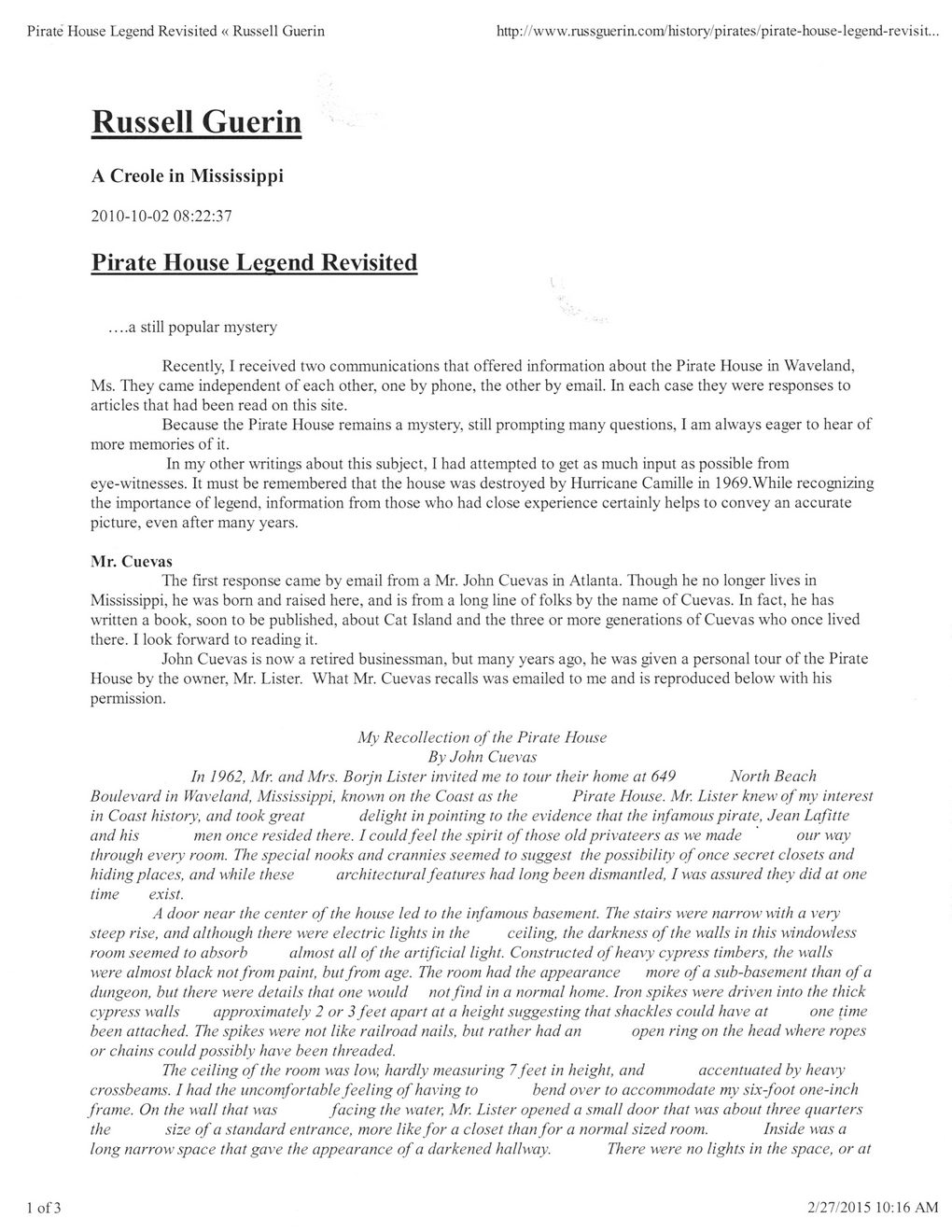This text was obtained via automated optical character recognition.
It has not been edited and may therefore contain several errors.
Pirate House Legend Revisited « Russell Guerin http://www.russguerin.com/history/pirates/pirate-house-legend-revisit.. Russell Guerin A Creole in Mississippi 2010-10-02 08:22:37 Pirate House Legend Revisited .. ..a still popular mystery Recently, I received two communications that offered information about the Pirate House in Waveland, Ms. They came independent of each other, one by phone, the other by email. In each case they were responses to articles that had been read on this site. Because the Pirate House remains a mystery, still prompting many questions, I am always eager to hear of more memories of it. In my other writings about this subject, I had attempted to get as much input as possible from eye-witnesses. It must be remembered that the house was destroyed by Hurricane Camille in 1969.While recognizing the importance of legend, information from those who had close experience certainly helps to convey an accurate picture, even after many years. Mr. Cuevas The first response came by email from a Mr. John Cuevas in Atlanta. Though he no longer lives in Mississippi, he was bom and raised here, and is from a long line of folks by the name of Cuevas. In fact, he has written a book, soon to be published, about Cat Island and the three or more generations of Cuevas who once lived there. I look forward to reading it. John Cuevas is now a retired businessman, but many years ago, he was given a personal tour of the Pirate House by the owner, Mr. Lister. What Mr. Cuevas recalls was emailed to me and is reproduced below with his permission. My Recollection of the Pirate House By John Cuevas In 1962, Mr. and Mrs. Borjn Lister invited me to tour their home at 649 North Beach Boulevard in Waveland, Mississippi, known on the Coast as the Pirate House. Mr. Lister knew of my interest in Coast history, and took great delight in pointing to the evidence that the infamous pirate, Jean Lafitte and his men once resided there. I could feel the spirit of those old privateers as we made our way through every room. The special nooks and crannies seemed to suggest the possibility of once secret closets and hiding places, and while these architectural features had long been dismantled, I was assured they did at one time exist. A door near the center of the house led to the infamous basement. The stairs were narrow with a very steep rise, and although there were electric lights in the ceiling, the darkness of the walls in this windowless room seemed to absorb almost all of the artificial light. Constructed of heavy cypress timbers, the walls were almost black not from paint, but from age. The room had the appearance more of a sub-basement than of a dungeon, but there were details that one would not find in a normal home. Iron spikes were driven into the thick cypress walls approximately 2 or 3 feet apart at a height suggesting that shackles could have at one time been attached. The spikes were not like railroad nails, but rather had an open ring on the head where ropes or chains could possibly have been threaded. The ceiling of the room was low, hardly measuring 7 feet in height, and accentuated by heavy crossbeams. I had the uncomfortable feeling of having to bend over to accommodate my six-foot one-inch frame. On the wall that was facing the water, Mr. Lister opened a small door that was about three quarters the size of a standard entrance, more like for a closet than for a normal sized room. Inside was a long narrow space that gave the appearance of a darkened hallway. There were no lights in the space, or at 1 of 3 2/27/2015 10:16 AM

Pirate House Document (011)